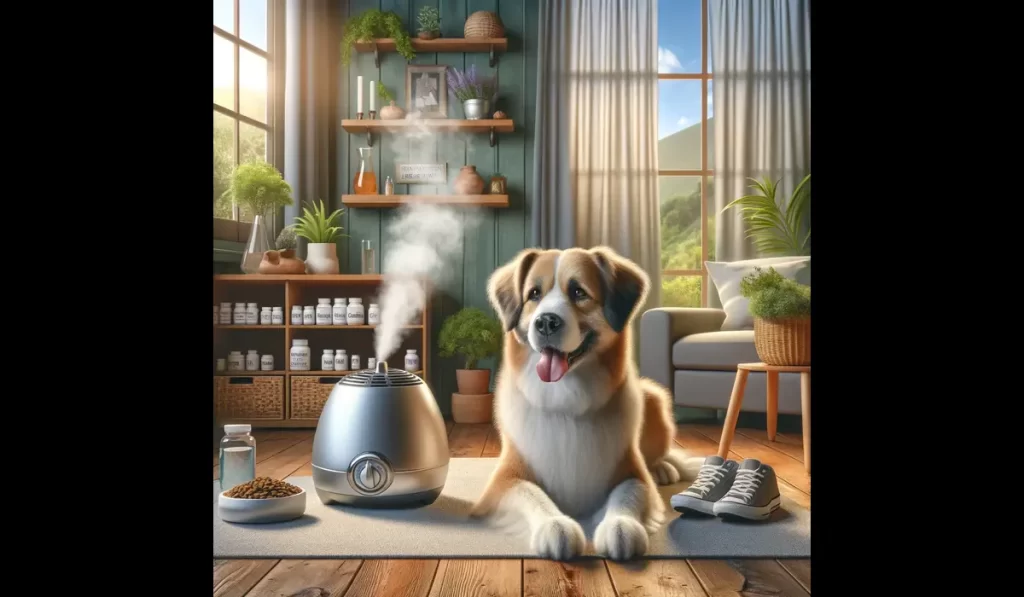Helping Your Dog Breathe Easier
Breathing difficulties in dogs can be alarming. Here’s what you need to know about the causes, symptoms, and ways to provide relief:
What is Dyspnea (Breathing Difficulty) in Dogs?
- Dyspnea refers to labored or difficult breathing in dogs.
- Common signs include heavy panting, flared nostrils, open-mouthed breathing, and loud, shallow breaths.
Potential Causes of Breathing Problems in Dogs
- Foreign Objects: Swallowed objects can block airways.
- Infections: Kennel cough, pneumonia, etc.
- Allergies: Seasonal allergies, pollen, dust, etc.
- Heart Disease: Can lead to fluid buildup in the lungs.
- Lung Disease: Conditions like lung cancer or pneumonia.
- Chest Injury: Trauma can damage respiratory organs.
- Anxiety: Stressful situations can trigger labored breathing.
Symptoms of Breathing Problems
- Rapid breathing (more than 30 breaths per minute)
- Exaggerated chest movements
- Noisy breathing
- Blue or purple gums
- Weakness or dizziness
How to Help Your Dog Breathe Better
- Immediate Veterinary Care: Breathing difficulties are an emergency. Seek veterinary help immediately.
- Oxygen Therapy: Your vet may recommend this in severe cases.
- Medication: Prescribed medications can address underlying causes and provide relief.
- Surgery: May be necessary for severe conditions or to remove obstructions.
Prevention and Management
- Humidifier: Moistens the air and can ease breathing for dogs with allergies.
- Weight Management: Maintain a healthy weight to reduce strain on the respiratory system.
- Exercise: Regular physical activity promotes overall health.
- Herbal Remedies: Consult your vet about natural anti-inflammatories (like quercetin) that may help with breathing issues.
- Vaccination: Protect your dog against preventable diseases like kennel cough.
- Steam Therapy: Short steam sessions can help clear airways.
- Keep Hazards Out of Reach: Prevent your dog from ingesting foreign objects that can block airways.
Key Takeaways
- Breathing difficulties in dogs are serious and require prompt veterinary attention.
- Understanding the causes and symptoms can help you provide immediate relief and seek appropriate treatment.
- Preventive measures like weight management, vaccinations, and a healthy lifestyle can minimize the risk of breathing problems.
- Always consult your veterinarian before administering any medication or herbal remedies.
Contents
What are Breathing Difficulties in Dogs?
Breathing is an involuntary action carried out in every animal required for survival. Any issue in the same is likely to cause great difficulties.
Medically known as Dyspnea, breathing problems are characterized by heavy panting and labored breathing.
These are common signs that can be caused due to excessive heat, dehydration, poor health, or as a result of physical exertion.
Breeds Susceptible to Breathing Difficulties
Breathing troubles occur due to excessive pressure on the respiratory tract. There is no breed or age at which it is protected from such issues.
Depending on the pet’s features, the cause of trouble can vary. Large dogs are at risk of heart risks, and small dogs have narrow nasal cavities and are at risk of the collapse of their trachea.
Irrespective of its size, the onset of any of these issues eventually leads to breathing problems. Dogs that are obese and have mobility issues are highly susceptible to Dyspnea.
Normal Breath Rate in Dogs
Knowing the normal rate of breaths taken by dogs in regular circumstances can help identify abnormal and excessive breathing. The general respiratory rate for dogs is between 15 to 30 per minute, only through the nose without any signs of exertion.
Symptoms of Breathing Problems in Dogs
Since your dog cannot explicitly communicate their emotions, it is up to you to observe and determine any difference in your dog’s behavior.
If your dog is having issues with breathing on its own, it is likely that it will not be able to bark and get your attention, which is why being attentive to pets is extremely important.
Hyperventilation
Suppose your dog is having difficulty taking in the air. In that case, it is likely to hyperventilate, which is the rapid huffing and puffing of the chest in an attempt to increase the intake of oxygen and the surface of the area through which it has to pass to mix with blood
.
Flared Nostrils
Nostrils of dogs are bound to flare up when they try to increase air intake.
Open-Mouth Breathing
Breathing in through the nose is insufficient to compensate for the body’s depletion of oxygen. To compensate, dogs tend to use their mouths for breathing.
Loud and Shallow Breaths
Since the brain is panicking, it sends signals to the body to breathe rapidly, resulting in short, rapid breaths with a loud noise.
Panting
Since the breaths are rapid and short, the tongue of the dog hangs outside the mouth, making sounds as it laps up air.
Lightheadedness and Dizziness
Due to the lack of oxygen transported to the brain, your dog may become lightheaded and lose balance.
Blue Gums
If the dog’s gums are tinted blue or purple, it may indicate breathing problems.
Possible Causes for Dog Breathing Problems
Diagnosing a respiratory problem is not an easy task and requires medical attention. However, there are some common causes of breathing problems in dogs.
Swallowing Foreign Objects
The trachea, bronchial tubes, and other respiratory system parts are extremely narrow. If your dog has swallowed or inhaled a small object, it ends up in pathways much smaller than the object’s size, thus blocking pathways and making the absorption of oxygen into the blood difficult and your dog uneasy.
Lung Cancer
Lung cancer is a rare type that affects senior dogs. It brings along with it side effects such as breathing trouble and coughing, amongst others.
Infections
Infections due to bacteria or viruses such as Pneumonia and Kennel Cough target the respiratory tract and make breathing difficult along with the formation of nasal mucus. The inflamed air sacs in the lungs are filled with fluid or pus.
Chest Wall Injuries
Chest wall injuries are rare and only occur when big accidents occur, such as car crashes involving dogs. In such a case, the entire body suffers damage, and the chest cavity can become crushed, directly affecting the major organs used in respiration and making breathing difficult.
Allergies
The immune system’s reaction to an allergen, which it sees as a threat to the body, is known as an allergic reaction.
Coughing and difficulty breathing are symptoms caused by seasonal allergies, pollen, dust, etc., that may trigger asthma and reactions in dogs, making them lethargic and breathing heavily.
Diseases in the Respiratory Tract
Diseases of the nose, throat, windpipe, lungs, and the diaphragm, which are the main components of the respiratory system, can make breathing difficult.
Anxiety
When placed in stressful situations, an anxious dog may likely get overwhelmed and have difficulty breathing.
How to Help a Dog Breathe Better?
The following stated remedies are only preventive methods to prevent any such problems from occurring in the future.
These methods are to assist as a temporary solution while you are on your way to the vet. These are by no means complete treatments to the problem. Taking your pet to the vet is necessary if you notice any of the symptoms mentioned above.
Oxygen Therapy
In emergencies, if you have your vet’s approval beforehand, you may set up oxygen administration devices at home.
This can be in the form of masks and cylinders to directly administer oxygen to your dog. This is usually only prescribed in serious cases with high chances of risk.
Immediate Checkup with the Vet
Breathing difficulties are classified as an emergency. You must rush to your vet at the earliest to ensure that your dog can be helped to return to its normal breathing pattern.
Medication
After the required tests are run, and symptoms are diagnosed, depending on the severity of the situation, using simple medication for a couple of days can ease the pain your dog is facing.
Ensure that the medicines are administered as per directions for them to perform effectively at the earliest.
Surgery
If the condition is severe and cannot be controlled using medicines, surgery may be the only option to bring your dog’s breathing back to normal.
This is used in situations where the lungs are filled with fluid or pus or in case of the collapse of any component of the respiratory system.
Install a Humidifier
Running a humidifier is an easy way to keep allergic reactions at bay. It releases moisture into the air, which settles on dust and other particles floating in the air, making them settle down.
You can now remove these particles using a vacuum on any other cleaning method and make breathing easier for your dog.
Manage your Dog’s Health
An overweight or obese dog is much more likely to suffer from breathing difficulties than a healthy dog. Ensure that you pay attention to your dog’s health by feeding it good quality dog food and taking it out for regular physical exercise.
At the very least, your dog requires 30 minutes of walking daily, which increases as per their breed and age.
Mental stimulation is just as necessary to ensure mental well-being and keep your dog healthy in all parameters. A well-mentally stimulated dog can better deal with stressful situations and prevent anxiety-induced breathing issues.
Herbal Remedies
Using herbal remedies like Quercetin, Mullein, licorice root, and Inula helenium, which are anti-inflammatory, can have positive effects on your pet while keeping inflammation-related issues away.
However, you must check with your veterinarian before introducing any new food to your dog’s diet. The same applies to any kind of medication, and further proceeding should only occur after getting your vet’s approval.
Vaccinations for Dogs
Making use of the advancements of science, ensure that you get your dog vaccines available to prevent kennel cough and other commonly transmittable problems.
Make Use of Steam
By using steam through baths or vaporizers, your dog’s sinuses can be kept clear, making the passage of air easier and clearing off any blockages.
Your dog may not enjoy either process, but it is a necessary preventive method that only needs to be run for a couple of minutes, not more than three times a week.
Keep Any Ingestible Items Out of Reach
Keep small objects your dog can ingest out of its reach to prevent blocking its airway.
Knowing how to help a dog breathe better is essential to dog parents. Still, following simple preventive methods along with your veterinarian’s advice can minimize such instances, and your dog lives a healthy life.








